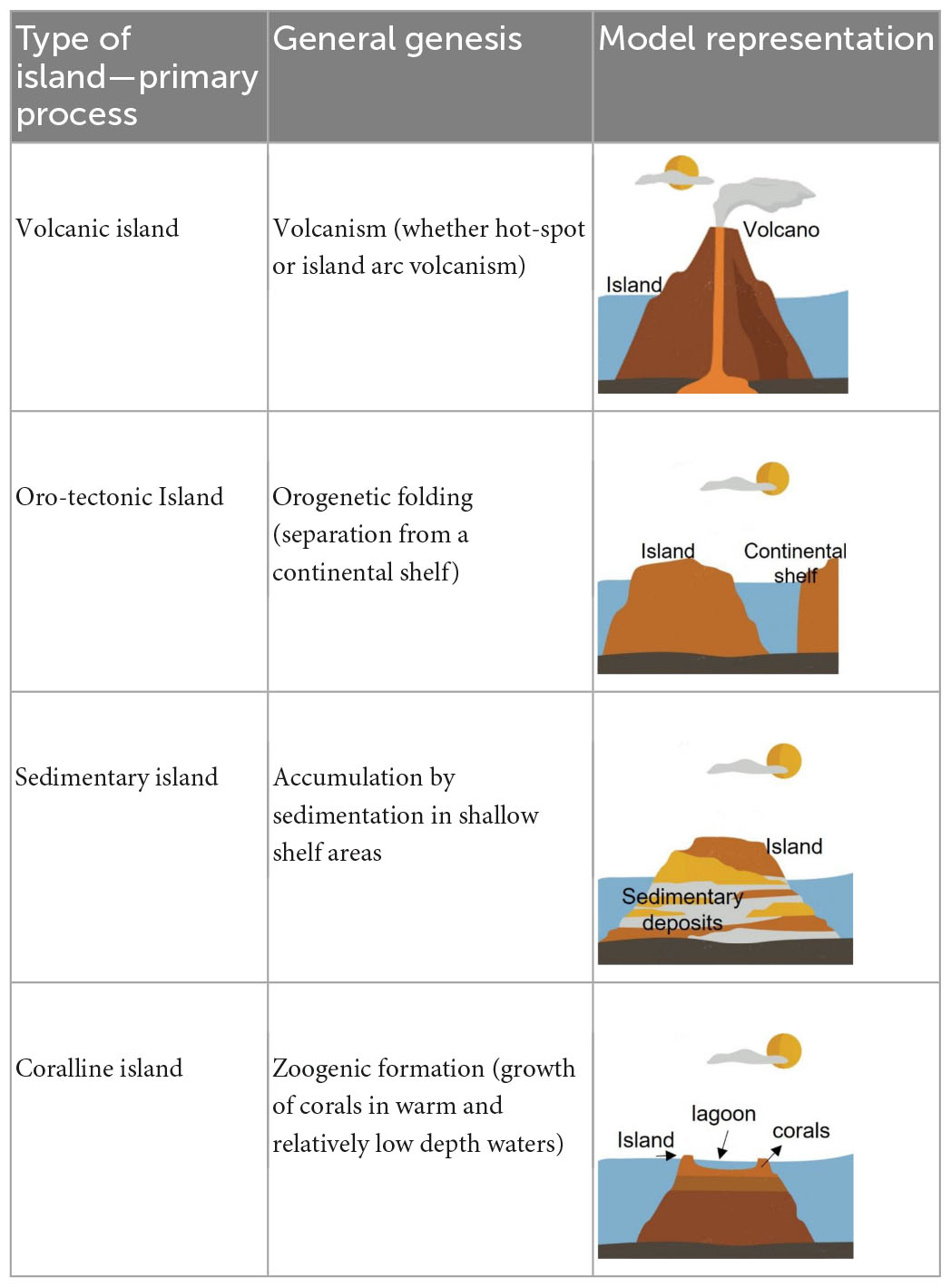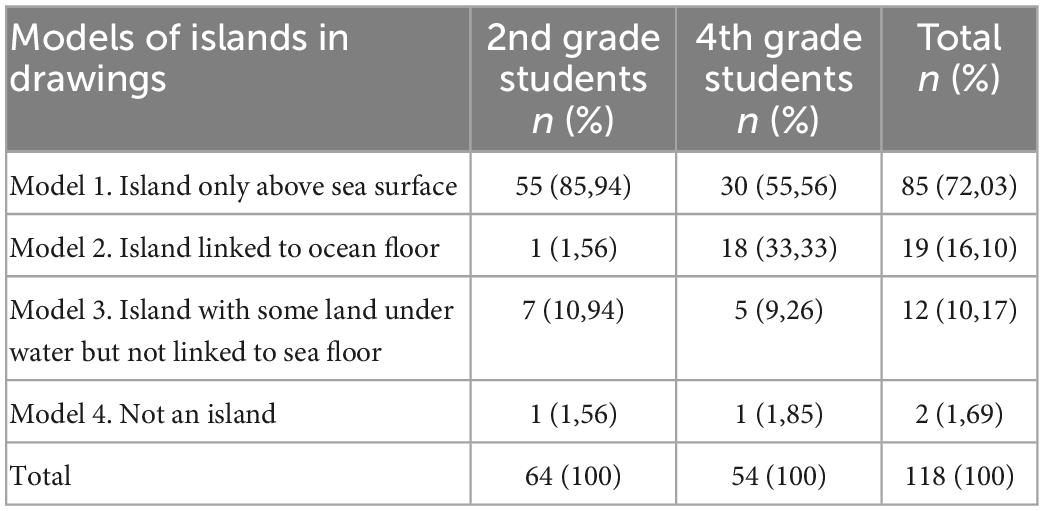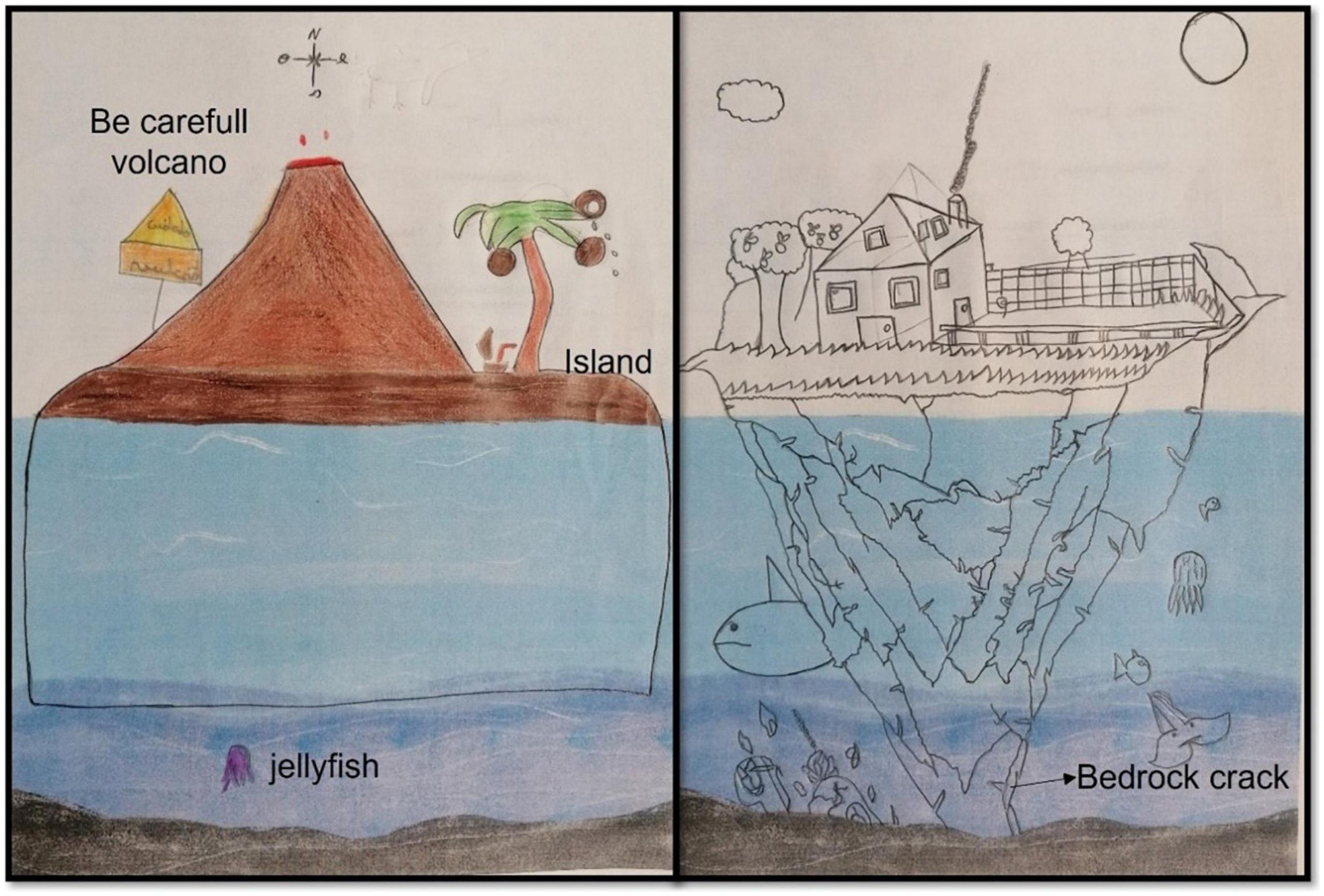- 1CIIMAR - Interdisciplinary Centre of Marine and Environmental Research, University of Porto, Porto, Portugal
- 2Science Teaching Unit, Department of Geoscience, Environmental and Land Planning, Faculty of Sciences, University of Porto, Porto, Portugal
Current challenges faced by modern societies assign larger importance to geological knowledge, particularly in the youngest, as geoscience education is an important path toward a more comprehensive understanding of the Earth’s processes and, therefore, to achieve a more sustainable world. The present investigation aims to deepen the knowledge regarding the conceptions related to islands and island formation. Children’s diagrams and drawings are prototypical representations of how they view and understand their world and can also illustrate misunderstandings in their knowledge. This study focuses on the conceptions of islands in elementary school children (K-9) and elementary school teachers. For that purpose, the investigation resorted to a small survey based on a drawing task. The sample consisted of 118 elementary school students (n = 118), whose ages ranged from 6 to 10 years, and their four elementary school teachers (n = 4), whose ages ranged from 43 to 49 years. In line with prior studies that acknowledged the existence of many misconceptions regarding geology topics, this investigation found unscientific ideas about islands, both in students and teachers. The study results also show that students and teachers share misconceptions about the formation of islands and their relation with the seafloor. The implications of our findings for science education are discussed, namely, the development of an Earth sciences education for elementary schooling and the construction of educational resources better adapted to the teaching and learning of the topic.
1. Introduction
Humans have always lived embedded in the natural environment, but the rise of modern and technology-dependent societies promoted an increased detachment between them and nature and brought up the need to achieve a reconnection between both (Beery et al., 2020; Paz et al., 2022). In fact, the relationship between people and the environment is one of the most important current issues of human survival (Shutaleva et al., 2021; Vasconcelos and Orion, 2021).
According to Balmer (2021), every child needs to understand their natural environment and how soils, rocks, weather, plants, and habitats work together. Geosciences education is a main force to address it as it allows the promotion of a more holistic view of the Earth system and its intertwined processes and dynamics, which are also related to the achievement of planetary sustainability (Ribeiro and Orion, 2021; Vasconcelos and Orion, 2021; Paz et al., 2022). In addition, all citizens should have some degree of geosciences literacy as it is progressively necessary to make informed and conscious decisions about contemporary issues such as climate change or the use of natural resources. As such, we recognize the need to start this from the early years of schooling.
Children already own predetermined ideas about how the world works when they first enroll in school. This can act as a barrier to learning scientific concepts (Adadan and Yavuzkaya, 2018; Cardoso et al., 2018). Thus, it is necessary to identify and understand these primary representations, rooted in previous life experiences, to understand how the learning process occurs and evolves (Gilbert and Watts, 1983; Adadan and Yavuzkaya, 2018; Cardoso et al., 2018).
Also, several times these preconceived ideas are not aligned with the scientifically accepted concepts, which gives rise to inaccurate or wrong conceptions. In the geosciences field, several authors recognize the existence of these (mis)conceptions regarding concepts, processes, and phenomena (Blake, 2005; Sibley, 2005; Francek, 2013; Cardoso et al., 2018; Guffey and Slater, 2020; Bakopoulou et al., 2021), whether in children or adults, as well as in teachers (Dahl et al., 2005; King, 2008; Corrochano and Gómez-Gonçalves, 2020).
There are thousands of islands of different sizes and shapes (Baldacchino, 2005; Whittaker and Fernández-Palacios, 2007). In total, almost one-quarter of the world’s countries are islands or archipelagos (Kueffer and Kinney, 2017), covering up approximately 2% of the Earth’s surface area (Ratter, 2018). Currently, there are approximately 86,000 inhabited islands, home to more than 600 million people (Baldacchino, 2018).
Islands studies are complex as they entail several features linking different disciplines, namely, anthropology, biology, geography, geology, and even social studies. As such, we might say that they are hotspots of geophysical, biological, and cultural diversity (Gillespie and Clague, 2009; Kueffer and Kinney, 2017).
Islands also offer opportunities for the teaching of sustainability subjects as they are among the most vulnerable places on Earth due to their greater susceptibility to environmental threats, like climate change and socioeconomic challenges (Kueffer and Kinney, 2017; Russell and Kueffer, 2019; Poti et al., 2022). For this reason, several studies even entail them as models for addressing sustainability studies, which may then be replicated in continental areas (Kueffer and Kinney, 2017; Poti et al., 2022).
The most known definition of an island refers to a portion of land surrounded by water (Pungetti, 2012; Ratter, 2018), smaller than a continent (Jêdrusik, 2011). The largest island in the world is Greenland. Australia, being more than three times the size of Greenland, is considered to be the smallest continent on our planet (Pungetti, 2012).
What about the part of the island that stays hidden underwater? Many studies refer to the lack of knowledge or misconceptions regarding this topic in children. The need for them to understand the concepts about islands is relevant since that knowledge develops scientific reasoning related to further and more cognitive scientific concepts. For example, knowledge about islands is important for geology and geography issues, like earthquakes, volcanism, hot spots, or plate tectonics. On the other hand, emergent biological topics also require accurate scientific knowledge about islands. For example, coastal planning for economic usages, such as tourism or fisheries, or land–sea connections with geology and the environment.
In Portugal, geographic landscapes are introduced to students in the third year of elementary school. An overview of several elementary textbooks presents the definition of an island as “a portion of land surrounded by sea on all sides.” This largely spread definition found in textbooks is not scientifically correct as an island is “a portion of land surrounded by water” but not necessarily “sea.” In addition, islands’ representations that are found in children’s books or cartoons relate to a piece of land on the surface, surrounded by water. There are no images in traditional textbooks of what lies underneath the water. Geosciences is not learned in Portuguese elementary schools, except on the topic of some rock types and their uses in society. As such, by the end of elementary school, children have not yet received any formal education regarding the island’s formation theme.
Also, Portuguese elementary school teachers may complete their degrees with little background in science knowledge. They may enroll in higher education courses to obtain a degree as teachers for elementary education, having attended social studies, language, or arts as fields of study during secondary education, thus, having little contact with disciplines within the scope of science in general, and of geosciences in particular.
Children’s drawings have long been considered valid representations of their ideas and how they view the world (Einarsdottir et al., 2009; Farland-Smith et al., 2014). Based on this assumption, this study addresses elementary school childrens’ and teachers’ conceptions of islands by answering a survey based on a drawing task.
We intend to diagnose their initial ideas about this topic, which were autonomously developed according to their life experiences and interpretations of the world (Kambouri, 2016; Cardoso et al., 2018), along with information probably provided by their parents, teachers, friends, cartoons, text or child books. Regarding the teachers, we aim to identify possible misconceptions.
During our literature review, we found no study regarding students’ or teachers’ conceptions of the island’s formation or its connection to geology. As such, our study may contribute to adding more data to this topic. Within this context, our purpose is to bring some glimpses that may contribute to developing a geoscience curriculum in elementary school years, namely, through the construction of simple but efficient resources for the teaching of islands and their formation, at the elementary school level.
2. Theoretical background
2.1. Misconceptions in (geo) science education at elementary school and the need to develop earth system education
Children develop their everyday concepts and ideas about the world supported by their daily observations (Libarkin and Kurdziel, 2001; Vosniadou, 2002, 2019; Anderson et al., 2014; Dolphin and Benoit, 2016). Thus, when they enter the formal school system, they are not blank boards as they already have intuitive conceptions of the world (Cardoso et al., 2018; Vosniadou, 2019). Following a constructivist perspective, we recognize that learning occurs through the integration of our previous ideas about the world with new information.
Many times, these concepts and ideas are not congruent with the scientifically correct concept or explanation of phenomena or processes. In specialized science education literature, the terms misconceptions, alternative conceptions, and preconceptions have been used alternately to refer to students’ ideas that are not congruent with the scientific theories and explanations (Dove, 1998; King, 2008; Vosniadou and Skopeliti, 2017).
These misconceptions developed in early years usually last over time and are often difficult to change (Garbett, 2003; Dolphin and Benoit, 2016; Bakopoulou et al., 2021). In fact, if they remain unchallenged, misconceptions may persist throughout schooling (Garbett, 2003; Francek, 2013) and until adulthood (Francek, 2013). Given that they are rooted in inaccurate or even wrong scientific conceptions, it is important to access students’ conceptions regarding a given topic as it allows the detection of unscientific ideas on the subject and therefore enables the building of new conceptions closer to the scientifically accepted ones (Clark et al., 2011; Cardoso et al., 2018). These new conceptions do not necessarily replace the old ones but instead co-exist with them (Vosniadou, 2019). In addition, these developments occur gradually and slowly, following a learning progression (Vosniadou, 2019).
Moreover, knowing and analyzing these misconceptions is essential for the construction of educational resources more adapted to the students’ and teachers’ needs, thus allowing for more efficient teaching and learning.
Enhancing science education allows students to distinguish between various scientific concepts and theories that occur in contexts that they might find in their daily lives. Also, science education research must address the importance of detecting and highlighting misconceptions as an initial step toward their isolation and elimination, so that new knowledge can continue to be built on solid scientific foundations (Gilbert and Watts, 1983). In addition, it increases the probability of avoiding new misunderstandings in their everyday life and further education (Stylos et al., 2021).
A substantial body of knowledge unraveled several misunderstandings about geological topics in students (Dove, 1998; Blake, 2005; Sibley, 2005; Francek, 2013; Mills et al., 2017; Cardoso et al., 2018; Guffey and Slater, 2020; Bakopoulou et al., 2021), adults (Cardoso et al., 2018), teachers (Dahl et al., 2005; King, 2008; Francek, 2013; Corrochano and Gómez-Gonçalves, 2020), or even textbooks (King, 2010). These investigations focused mainly on geological issues related to the internal structure of the Earth, plate tectonics, geological time scale, rocks, and mineral formation, volcanology, and seismology.
Despite being essential for understanding how the natural world works, Earth science literacy is still restricted in the world (Bakopoulou et al., 2021; Vasconcelos and Orion, 2021). As such, developing it must be a concern for science education.
Geological topics are referred to as difficult to address in the youngest as they are not easy to observe. Actually, most of the time, they cannot be observed at all. They take place on enormous temporal and spatial scales (Dolphin and Benoit, 2016; Conrad and Libarkin, 2022), making them difficult to understand without the ability to think in an abstract and systemic way (Blake, 2005; King, 2008), which can be a real challenge in early years of schooling. Teachers can also contribute to this outcome when they often assume that students will acquire and understand all new knowledge only by attending lecture-type classes (Dolphin and Benoit, 2016).
Geosciences, or Earth sciences, includes an interdisciplinary set of scientific fields that aim to study the planet and its history, structure, composition, processes, and phenomena that occur in it (Kleinhans et al., 2010; Ribeiro and Orion, 2021).
In the last decades, many authors within geosciences education acknowledged the necessity of addressing the Earth system’s education to promote a more holistic view of the Earth and of the Earth processes (Orion, 2016; Scherer et al., 2017; Ribeiro and Orion, 2021; Vasconcelos and Orion, 2021). By reinforcing the interconnections and interdependence between its subsystems (atmosphere, biosphere, cryosphere, geosphere, and hydrosphere), this approach challenges more traditional ones, in which processes and phenomena are taught and learned as isolated events (Skinner and Murck, 2011; Ribeiro and Orion, 2021). In this sense, the Earth system’s education moves away from more reductionist views of teaching (Scherer et al., 2017; Ribeiro and Orion, 2021).
The success of this approach depends on students system thinking abilities development (Orion and Libarkin, 2014; Orion, 2016; Scherer et al., 2017). The development of system thinking is related to a high level of abstraction, allowing learners to be able to interrelate concepts (Ben-Zvi-Assaraf and Orion, 2005; Ribeiro and Orion, 2021). This is particularly important in geosciences education as the geological processes and dynamics occur on huge spatial and temporal scales and are dependent on the interaction between and among different Earth subsystems.
Teachers should uphold students from all academic levels to undertake activities that imply higher-order thinking skills (Zohar and Dori, 2003; Ben-Zvi-Assaraf and Orion, 2010). Furthermore, expanding a system thinking perspective is more efficient as it takes less time when started at younger ages, like in elementary school, where children exhibit a much more inquisitive and open mind (Forrester, 2007; Ben-Zvi-Assaraf and Orion, 2010).
2.2. Types of islands
According to the current geological knowledge, “planet Earth is about 4.56 billion years old” (Grotzinger and Jordan, 2014, p. 19). Nevertheless, the visible surface of the Earth is relatively young and continuously moving, so the current topography and landscape are ephemeral. Unsurprisingly, some islands are relatively old when compared to the geological age of the Earth, whereas the birth of others, mostly in volcanic island regions, can be witnessed almost in real time (Neall and Trewick, 2008; Ratter, 2018).
As mentioned earlier, islands come in different forms and shapes. They are outcomes of several geological processes that occurred over thousands or even millions of years. They are ocean “tall features” as they “reach from the sea floor all the way above sea level” (Trujillo and Thurman, 2011, p. 94).
In general terms, the formation of an island results from the interplay between these geological (physical) processes and sometimes also involves biological ones (Baldacchino, 2018, p. 22; Ratter, 2018, p. 25). The first category includes volcanism, tectonics elevation or folding, and sedimentation, whereas the latter is associated with the presence of biogenic coral formation (Ratter, 2018).
With so many events in the play, it is difficult to find a unified classification of islands as different authors have their own classifications.
In this work, we will consider the typology of islands, acknowledged by Ratter (2018). This author considers that regarding their origin, a typology of islands should recognize four primary processes. These processes later originate different types of islands, such as volcanic islands, tecto-orogenetic islands, sedimentary islands, or coralline islands, as presented in Table 1.
The number and combination of processes involved in the formation of an island also greatly influence its size. Usually, smaller islands have better chances of being formed by only one dominant process (Depraetere and Dahl, 2018).
At the same time, our knowledge about geotectonic movements, sea level changes, and island-building processes allows us to see the islands that presently appear on the sea surface, not as eternal entities but as one static image captured from ongoing processes which include islands expanding and shrinking, joining up or being detached, appearing or being hidden under the sea through time (Baldacchino, 2018; Ratter, 2018).
3. Materials and methods
This study resorted to a survey based on both a drawing task and an answer to one question. Content analysis was applied to the drawings, and statistical tests were performed using the IBM® SPSS® software version 28.
The survey was applied to a convenient sample of 122 participants (n = 122) from two different groups: 118 elementary school students (n = 118) and their four elementary school teachers (n = 4). Students’ ages range between 6 and 10 years (average age = 7,92). The students’ group consisted of 66 girls (n = 65; 55,9%) and 52 boys (n = 52; 44,1%). They were enrolled in two different school years: 64 in a second-grade classroom (n = 64, 54,2%) and 53 in a fourth-grade classroom (n = 54; 45,8%). The students’ teachers who accepted to participate in this study consisted of four females (n = 4, 100%), with ages ranging between 43 and 49 years (average age = 45,75). The sample characterization is presented in Table 2.
Participants were from the same public urban school. The reason to apply the survey to students of the second and fourth school years was result of the availability shown by the elementary teachers to collaborate in the research. Elementary teachers of the first and third school years were behind the scheduled time to finish the curricular program and, for this reason, could not be involved.
3.1. Instrument
To understand elementary school students’ and teachers’ conceptions of islands, a small survey was developed by the research team and then applied to all participants. The survey validity and reliability were ensured by doing content validation. As such, we resorted to (i) a literature review regarding the specific theme; (ii) an evaluation of the survey by a panel of experts in science (geo)education; and (iii) a consensus meeting between the experts to reach the final version of the survey.
In addition to the demographic data, like age, school year, and gender (since students involved in this study were quite young, we just used the two traditional genders, “female” or “male”), participants were asked (i) to make a drawing of an island over a pre-printed background, which intended to represent the cross-section of the sea and the sky (Supplementary material), they were also free to draw other features related to the topic, according to their desire, and paint or label the drawings and (ii) to answer a question about whether they believed that it was possible, or not, to swim under an island (e.g., a human, a shark or other fish).
3.2. Procedure
Data were collected in a public elementary school in an urban area in the north of Portugal. Participants were enrolled in six different classrooms, and each of them filled out the questionnaire and made the drawing in their respective classes. The task was completed within 15–30 min.
4. Results
The drawings were subject to content analysis. First, we determined which drawings (i) only represented the island above the sea level and (ii) also represented the unseen part of the island under the sea surface, whether it reached the seafloor or not. We grouped the designs into four different categories (Table 3): (i) drawings representing islands above the sea surface; (ii) drawings representing islands both above the sea surface and linked to the ocean floor; (iii) drawings representing islands above the sea surface and with some land underwater, but without reaching the sea floor; and (iv) drawings with no island representation. The results are presented in Table 3.
As shown in Table 3, only 19 students (n = 19; 16,10%) have represented the island in a scientifically correct way, linking its’ surface to the ocean floor (model 2). The majority of participants represented the island in a non-scientific way (models 1, 3, and 4) as it was floating on the ocean (n = 97; 82,20%). Most of them drew an island only above the sea surface (n = 85; 72,03%), and others represented some land above water but without connection to the ocean floor (n = 12; 9,84%). Two participants did not represent an island at all (n = 2; 1,64%).
Some of the more representative drawings made by the students are presented in Figure 1.
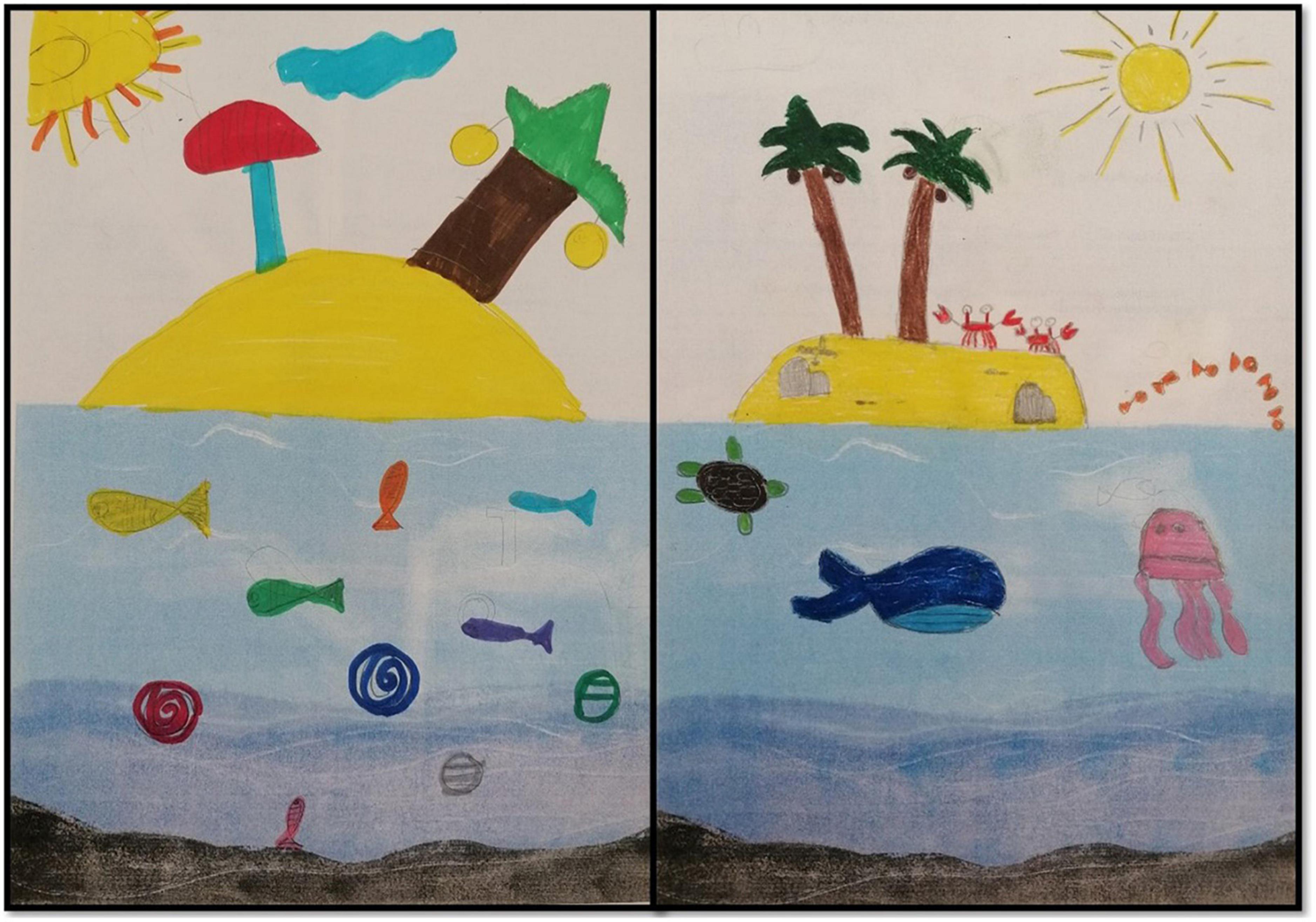
Figure 1. Most representative drawings were made by students, which included the island drawn only above the sea level, trees, sea animals, and weather features (on the left, a drawing by a second-grade student, and on the right, a drawing by a fourth-grade student).
In Figure 2, we present other drawings, also made by the students. In those drawings, the students represented islands with some land below the sea surface but without reaching the seafloor. These drawings also present some other features, like submarines, mythological creatures (like mermaids), persons, planes, or seaweeds.
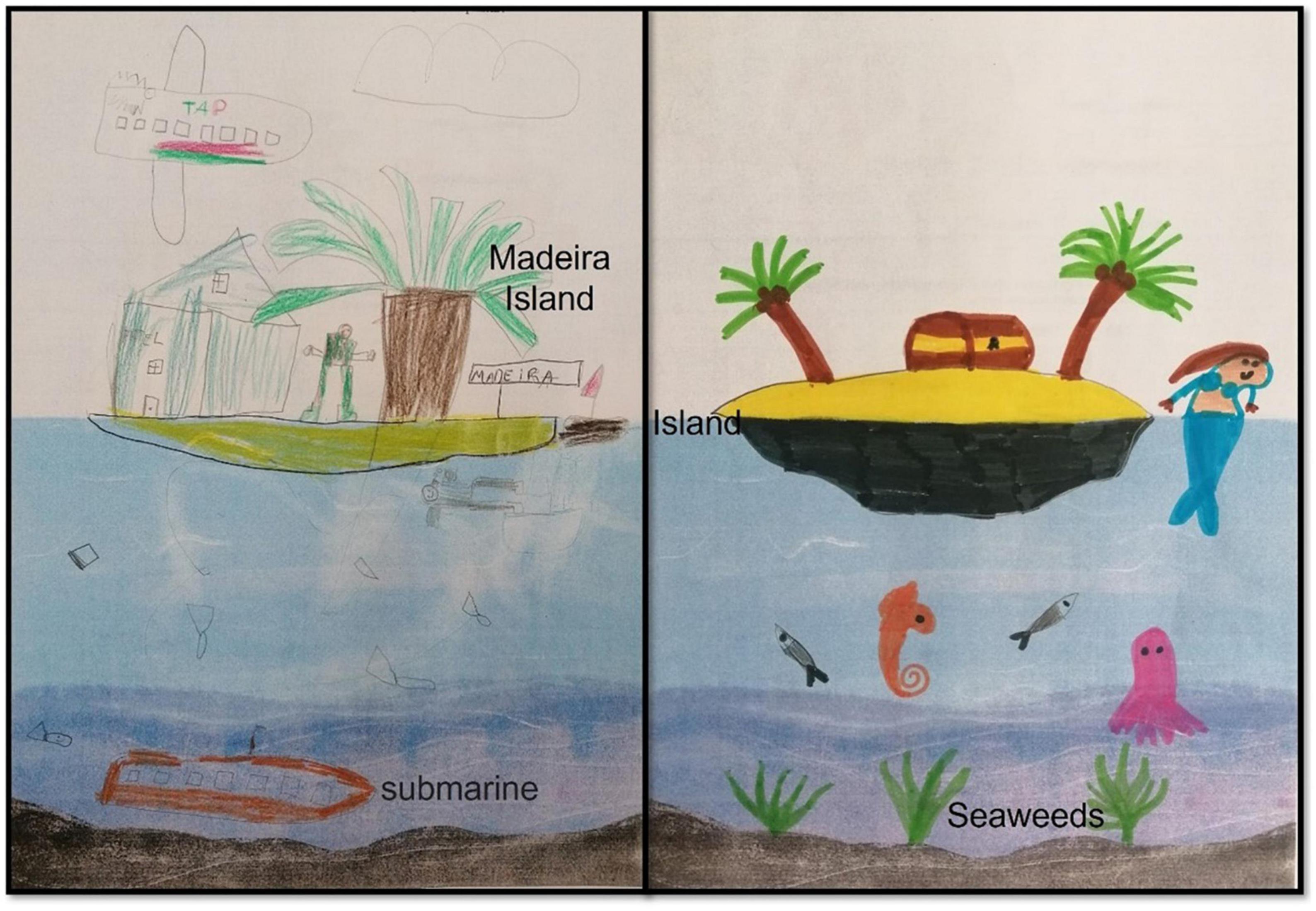
Figure 2. Drawings representing islands with some land under the sea level and some other elements, such as a submarine, a mermaid, or seaweeds (on the left is presented a drawing by a second-grade student and on the right a drawing from a fourth-grade student).
Although in a much less number, some of the students were able to draw an island according to the scientifically accepted conception, as shown in Figure 3.
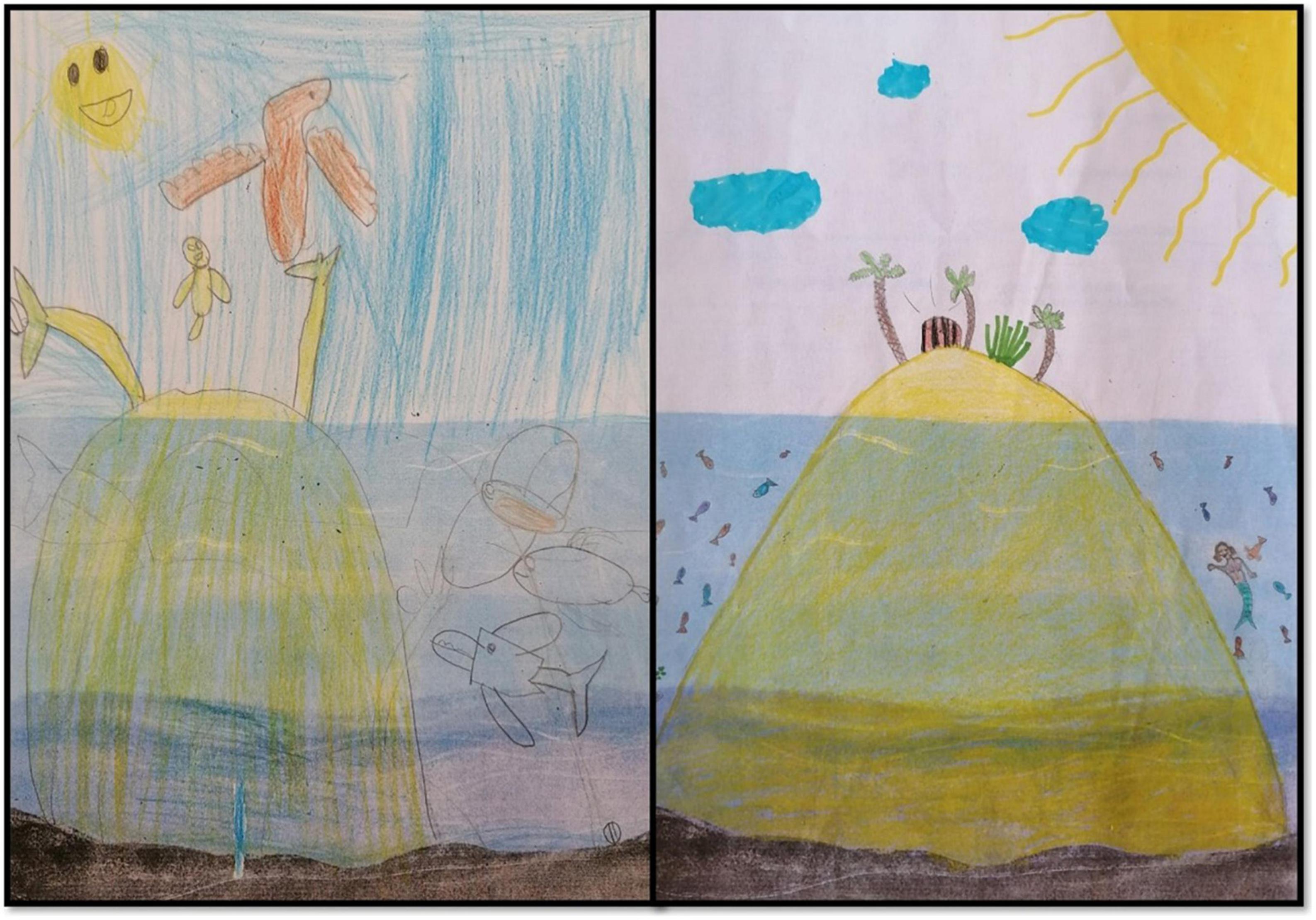
Figure 3. Drawings representing the island all the way down to the sea floor—model 2 (on the left is a drawing presented by a second-grade student, and on the right is a drawing from a fourth-grade student).
In order to analyze if statistically significant differences were observed between the types of drawings made by students and the school grade they attended, we joined the drawings into two groups: (i) Those with the scientifically accepted conception of islands (model 2) and (ii) those with unscientific conceptions (models 1, 3, or 4). The chi-square analysis is presented in Table 4.

Table 4. Chi-square independence test result concerning students’ grades and the island drawn by them.
No differences were found between girls and boys, and the conception held about islands (χ2 = 0,100; p = 0,752).
Regarding special elements portrayed in the drawings, one of the students (n = 1; 0,85%) represented a volcano, revealing knowledge about a type of island’s formation. Nevertheless, the same student could not link the bottom of the island completely to the seafloor, as shown in Figure 4.
A few students made their drawings of the bedrock under the water with cracks or caves (n = 4; 3,39%), as presented in Figure 4.
Although it was not the focus of this work, several other features were drawn by students, namely, mythological elements, such as mermaids or marine monsters (n = 17; 13,9%), elements usually linked to pirates, like pirate boats, pirate flags, treasures maps or treasure arcs (n = 10; 8,2%), and seaweeds (n = 12; 9,8%).
Students also had to respond to a question of whether they thought it was possible, or not, to swim beneath an island. The answers from the two participants who had not been able to draw an island in the image of the sea were excluded from this analysis.
The answers revealed that most of the students thought it was possible to swim beneath the island (n = 67; 57,8%), 45 students answered that it was not possible (n = 45; 38,8%), three students (n = 3; 2,6%) responded that it depended on whether the rocks that are beneath the island surface had caves or not, and one student answered: “I don’t know” (n = 1; 0,9%).
To understand if the answers to this question were aligned with the island conception shown by students in their drawings, we compare them to both school grades and, in total, with the type of island students made in the drawing, as presented in Table 5.

Table 5. Students’ answers to the question “Do you think it is possible for a diver to swim beneath an island from one side to the other?” regarding their school grades and the model of the island they have drawn.
We considered that the correct answer was “no” because once the island is linked to the seafloor, it is not possible to swim beneath it. We also considered that the students who responded, “It depends if there are caves in the rocks underwater” were correct as they provided a plausible explanation. In theory, it can be possible to cross a bedrock if it has various caves lined up so that swimming across them can be accomplished.
Thereby, crossing the results from the two tasks proposed to the students, the drawing and the question, there was a total of 15 correct answers (n = 15; 12,9%), all given by students enrolled in the fourth grade.
In line with the students’ conceptions, the teachers’ drawings also revealed misconceptions about islands, as presented in Table 6. Participant teachers only represented the island according to models 1, 2, or 4.
As shown in Figure 5, we present two drawings made by elementary teachers. On the left is a representation of model 1, and on the right is a representation of model 2.
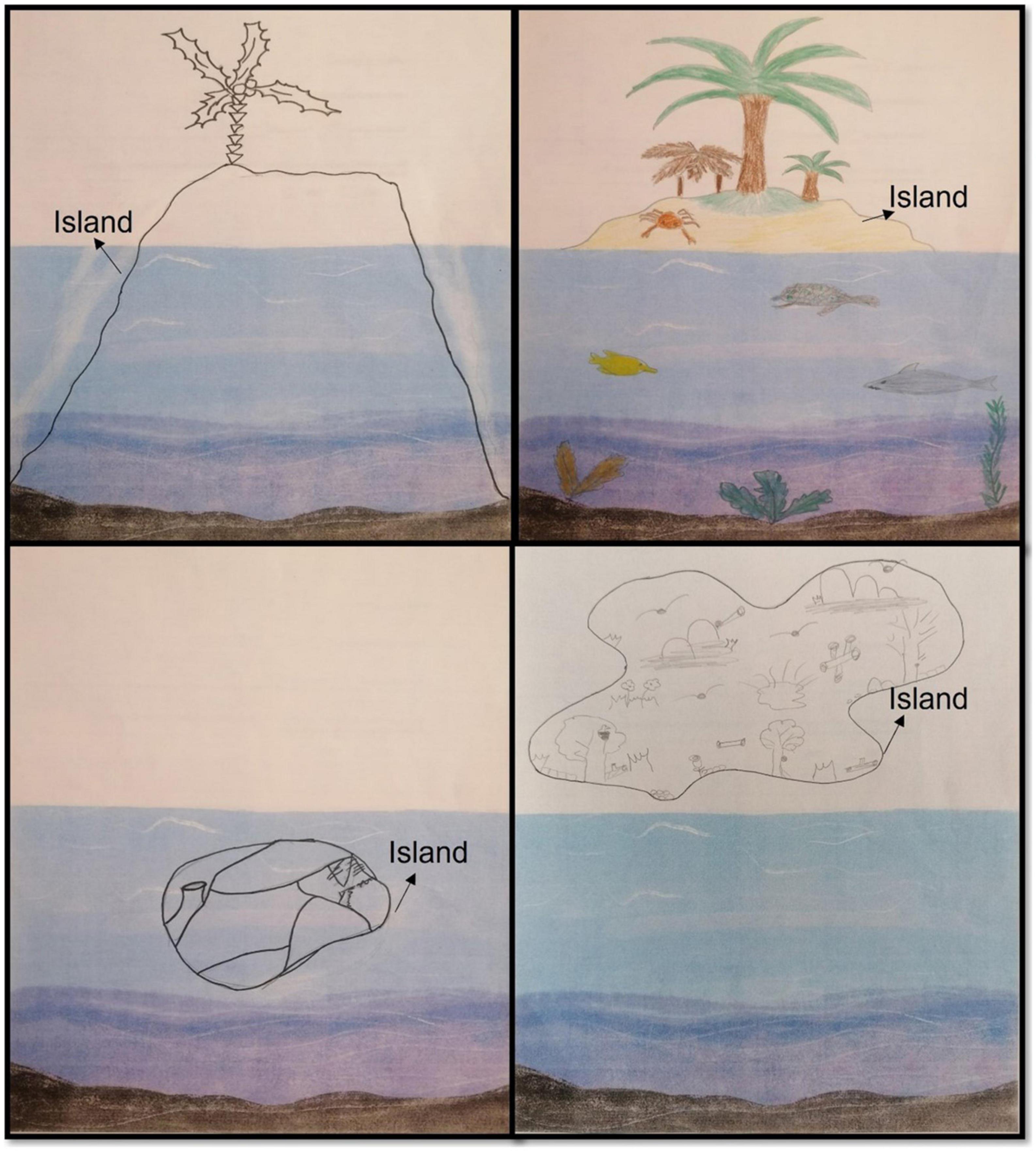
Figure 5. Drawings of islands by teachers (on the top left, a model 2 island exhibiting a scientifically correct conception, the other three drawings portrayed misconceptions regarding the theme).
Regarding the answer to the question, “Do you think it is possible for a diver (humans or fishes) to swim beneath an island from one side to the other?” the participant teachers responded as presented in Table 7.

Table 7. Teachers’ answers to the question, “Do you think it is possible for a diver (humans or fishes) to swim beneath an island from one side to the other?”
One of the participant teachers (n = 1; 25%) answered correctly and presented the drawing of the island aligned with the scientifically accepted conception; the other three (n = 3; 75%) revealed misconceptions about this topic.
Regarding our total findings, only 16 participants (n = 16; 13,11%), one teacher (n = 1; 25%), and 15 students (n = 15; 12,93%) were able to draw an island according to the scientifically accepted conception, which is linking it to the seafloor, and at the same time answering that it is not possible to swim beneath an island, except in the case of existing some caves aligned on the rocky layers below the surface, in such a way which would allow them to be crossed.
5. Discussion
As in prior research studies (Sibley, 2005; Shepardson et al., 2007; Smith and Bermea, 2012; Anderson et al., 2014; Cardoso et al., 2018), the drawings also provided interesting insights into students’ conceptions of this investigation topic.
In our study, most of the participants exhibited unscientific conceptions about the formation of islands. Students mostly portrayed the island as if it was floating on the sea surface. This may happen because science content is still taught in a very fragmented way (Jaimes et al., 2020), not allowing the understanding of the underlying processes involved in an island formation. As most of these processes cannot be seen due to the huge temporal and spatial scale in which they occur, students have difficulties understanding them (Dolphin and Benoit, 2016; Conrad and Libarkin, 2022). Furthermore, their comprehension demands the ability to abstract thinking (Blake, 2005; King, 2008) and system thinking (Ben-Zvi-Assaraf and Orion, 2005), that lacks in most of the youngest (Ben-Zvi-Assaraf and Orion, 2010).
In addition, searching in elementary Portuguese textbooks, we could not find any image of an island with the representation of what lies underneath the sea level. The images of islands repeatedly consist only of the “piece of land surrounded by water” above the seafloor, as revealed by an online search in some photo repositories (Figure 6).
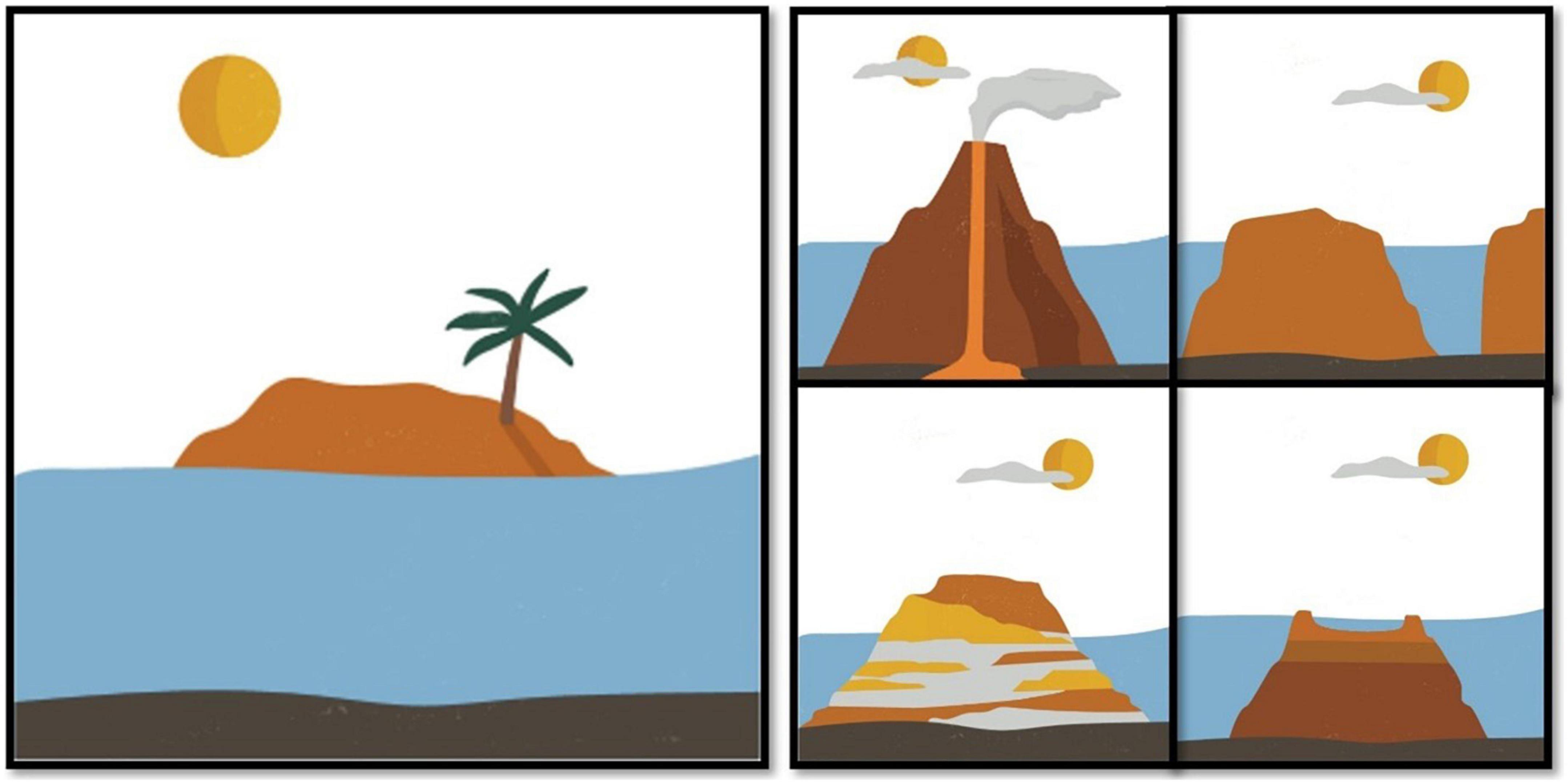
Figure 6. The most common type of image representing an island in child books or online searches is on the left, and four proposals for portraying islands, according to the scientific consensus are on the right (illustrations credits to Pat Sousa).
Aligned with the most common drawing made by the participant students, this island’s image consists of a piece of land surrounded by the sea, with the sun and a palm tree. As this topic is not explicitly addressed at this school level, this misconception about islands might also be related to the influence of media on children as some studies point out that they are regular consumers (Strasburger et al., 2013; Rideout, 2016). The representations of mythological elements made by students in their drawings are an indicator of this as these elements are frequently addressed in child books or cartoons. Surprisingly there is little research done about how science is represented in popular children’s media and how exposure to this media can play a role in children’s science knowledge (Bonus and Mares, 2018), which highlights the need to further investigate the topic.
Although not part of the purpose of our study, another curious fact relates to the way students represented seaweeds in their drawings since they colored them all in green (like in Figure 2). This may be related to some alternative conceptions common in students regarding the process of photosynthesis and to the confusion between what are plants and what are seaweeds as supported in the literature (Wood-Robinson, 1991; Griffard and Wandersee, 2001; Ekici et al., 2007). Interestingly, the only teacher’s drawings with seaweed representations were drawn not only in green (see Figure 5). According to Balmer (2021), many elementary school teachers reveal that the only science they feel comfortable teaching is biology, which may indicate stronger levels of knowledge in this subject.
As expected, fourth-grade students revealed better outcomes than second-grade ones. Students’ conceptions evolve gradually as they become older and have the opportunity to go through more experiences in life. Also, as they complete steps along their formal schooling, they enrich their theoretical frameworks, being able to construct new concepts closer to the scientifically accepted ones (Adadan and Yavuzkaya, 2018; Cardoso et al., 2018).
As aforementioned, in Portugal, geology is not explicitly learned until the seventh grade, when students learn concepts like plate tectonics and volcanology. As these processes are involved in forming an island, it was expected that elementary school students would only address their prior ideas for completing the task proposed in this study. We found no other study regarding this investigation topic. Notwithstanding, other studies that have focused on other geoscience content have also found several misconceptions among the youngest (Blake, 2005; Cardoso et al., 2018). As these misconceptions persist over time, as revealed by several research studies with older students (Sibley, 2005; Clark et al., 2011; Francek, 2013; Conrad and Libarkin, 2022), it is important to diagnose and act upon them, in order to bring them closer to the scientifically accepted conceptions.
Earth science concepts are taught in Portuguese elementary schools along with biology, geography, and history. Although there have been some efforts to improve the Portuguese elementary Earth science curriculum, it continues to be scarce and fragmented, with unclear joints with the rest of the curriculum. According to Balmer (2021), this is also the case in England.
Prior research also acknowledges that science-content knowledge of teachers enrolled in early and elementary schooling is poor (Trundle et al., 2002; Garbett, 2003; Davis et al., 2006; Anderson et al., 2014), namely, in the geosciences field (Dahl et al., 2005; King, 2008; Corrochano and Gómez-Gonçalves, 2020; Balmer, 2021). This condition is aligned with the teachers’ outcomes in this study.
These results address the need to change the way islands are represented. By incorporating images like those presented in Figure 6, students could better understand that something is upholding the island beneath the visible surface. Furthermore, it could be a starting point to address the Earth system approach and develop system thinking in elementary students.
5. Conclusion and implications
Geosciences education is essential to ensure the development of responsible citizens, able to make decisions on everyday matters. In addition, it develops system thinking, a competency essential to understand the Earth as a holistic system whose subsystems influence and are influenced by each other.
Our findings suggest that in Portugal there are several misconceptions regarding the island formation topic among pupils and elementary school teachers. As these unscientific ideas may be persistent over time, it is essential to diagnose them to enhance the teaching about islands. Through professional development actions, conceptual change can be achieved. Teaching a topic with correct scientific knowledge is essential to drive students to avoid misconceptions themselves. Since changing a misconception is hard, and as they easily return when students have difficult problems to solve, it is imperative that the teaching is scientifically accurate.
Our study also indicated that about a third of the fourth-grade students expressed a scientific perception of islands, although many were misconceptions. It is unlikely that the science textbooks and the teachers are the main sources of their schools’ scientific perceptions. Regarding this evidence, future studies may explore which external sources influence the development of scientific perceptions about islands in children.
We argue in favor of a more scientific representation of these features in textbooks, portraying the linkage between the landscape of the island above the sea level and the part of the island that is hidden underneath the surface, which is attached to the seafloor. This might be a simple way to promote not only knowledge about island formation but also students’ ability to use systems thinking, which is essential for correctly understanding the intertwined relations among the Earth system.
Data availability statement
The raw data supporting the conclusions of this article will be made available by the authors, without undue reservation.
Ethics statement
The studies involving human participants were reviewed and approved by the Faculty of Sciences Ethical Commission. Written informed consent to participate in this study was provided by the participants’ legal guardian/next of kin.
Author contributions
CV: conceptualization and supervision. MP: data collection. CV and MP: data analyses, the writing of original draft preparation, and the writing of review and editing. Both authors have read and agreed to the published version of the manuscript.
Funding
This research was supported by the Strategic Funding (refs. UIDB/04423/2020 and UIDP/04423/2020) through national funds provided by the Portuguese National Funding Agency for Science, Research, and Technology [Fundação para a Ciência e a Tecnologia (FCT)].
Acknowledgments
We authors would like to thank the valuable contribution of Pat Sousa for providing all the illustrations in this study free of charge.
Conflict of interest
The authors declare that the research was conducted in the absence of any commercial or financial relationships that could be construed as a potential conflict of interest.
Publisher’s note
All claims expressed in this article are solely those of the authors and do not necessarily represent those of their affiliated organizations, or those of the publisher, the editors and the reviewers. Any product that may be evaluated in this article, or claim that may be made by its manufacturer, is not guaranteed or endorsed by the publisher.
Supplementary material
The Supplementary Material for this article can be found online at: https://www.frontiersin.org/articles/10.3389/feduc.2023.1115984/full#supplementary-material
References
Adadan, E., and Yavuzkaya, M. N. (2018). Examining the progression and consistency of thermal concepts: A cross-age study. Int. J. Sci. Educ. 40, 371–396. doi: 10.1080/09500693.2018.1423711
Anderson, J. L., Ellis, J. P., and Jones, A. M. (2014). Understanding early elementary children’s conceptual knowledge of plant structure and function through drawings. CBE Life Sci. Educ. 13, 375–386. doi: 10.1187/cbe.13-12-0230
Bakopoulou, A., Antonarakou, A., and Zambetakis-Lekkas, A. (2021). Existing and emerging students’ alternative ideas on geodynamic phenomena: Development, controlling factors, characteristics. Educ. Sci. 11:646. doi: 10.3390/educsci11100646
Baldacchino, G. (Ed.) (2018). The routledge international handbook of island studies: A world of Islands, 1st Edn. Abingdon: Routledge. doi: 10.4324/9781315556642
Balmer, D. (2021). The value of short earth science continuing professional development for trainee primary school teachers. Geosci. Commun. 4, 33–41. doi: 10.5194/gc-4-33-2021
Beery, T., Chawla, L., and Levin, P. (2020). Being and becoming in nature: Defining and measuring connection to nature in young children. Int. J. Early Child. Environ. Educ. 7, 3–22.
Ben-Zvi-Assaraf, O. B. Z., and Orion, N. (2010). System thinking skills at the elementary school level. J. Res. Sci. Teach. 47, 540–563. doi: 10.1002/tea.20351
Ben-Zvi-Assaraf, O., and Orion, N. (2005). Development of system thinking skills in the context of earth system education. J. Res. Sci. Teach. 42, 518–560. doi: 10.1002/tea.20061
Blake, A. (2005). Do young children’s ideas about the Earth’s structure and processes reveal underlying patterns of descriptive and causal understanding in earth science? Res. Sci. Tech. Educ. 23, 59–74. doi: 10.1080/02635140500068450
Bonus, J. A., and Mares, M. L. (2018). When the sun sings science, are children left in the dark? Representations of science in children’s television and their effects on children’s learning. Hum. Commun. Res. 44, 449–472. doi: 10.1093/hcr/hqy009
Cardoso, A., Ribeiro, T., and Vasconcelos, C. (2018). What is inside the earth? Sci. Educ. 27, 715–736. doi: 10.1007/s11191-018-0003-y
Clark, S. K., Libarkin, J. C., Kortz, K. M., and Jordan, S. C. (2011). Alternative conceptions of plate tectonics held by nonscience undergraduates. J. Geosci. Educ. 59, 251–262. doi: 10.5408/1.3651696
Conrad, D., and Libarkin, J. C. (2022). Using conceptual metaphor theory within the model of educational reconstruction to identify students’ alternative conceptions and improve instruction: A plate tectonics example. J. Geosci. Educ. 70, 262–277. doi: 10.1080/10899995.2021.1983941
Corrochano, D., and Gómez-Gonçalves, A. (2020). Analysis of Spanish pre-service teachers’ mental models of geologic time. Int. J. Sci. Educ. 42, 1653–1672. doi: 10.1080/09500693.2020.1774093
Dahl, J., Anderson, S. W., and Libarkin, J. C. (2005). Digging into earth science: Alternative conceptions held by K-12 teachers. Sci. Educ. 6:65.
Davis, E. A., Petish, D., and Smithey, J. (2006). Challenges new science teachers face. J. Educ. Res. 76, 607–651. doi: 10.3102/0034654307600460
Depraetere, C., and Dahl, A. (2018). “Locations and classifications,” in The Routledge international handbook of island studies, ed. G. Balacchino (Abingdon: Routledge), 21–51.
Dolphin, G., and Benoit, W. (2016). Students’ mental model development during historically contextualized inquiry: How the ‘tectonic plate’metaphor impeded the process. Int. J. Sci. Educ. 38, 276–297. doi: 10.1080/09500693.2016.1140247
Dove, J. E. (1998). Students’ alternative conceptions in Earth science: A review of research and implications for teaching and learning. Res. Pap. Educ. 13, 183–201. doi: 10.1080/0267152980130205
Einarsdottir, J., Dockett, S., and Perry, B. (2009). Making meaning: Children’s perspectives expressed through drawings. Early Child Dev. Care 179, 217–232. doi: 10.1080/03004430802666999
Ekici, F., Ekici, E., and Aydin, F. (2007). Utility of concept cartoons in diagnosing and overcoming misconceptions related to photosynthesis. Int. J. Environ. Sci. Educ. 2, 111–124.
Farland-Smith, D., Finson, K., Boone, W. J., and Yale, M. (2014). An investigation of media influences on elementary students representations of scientists. J. Sci. Teach. Educ. 25, 355–366. doi: 10.1007/s10972-012-9322-z
Forrester, J. W. (2007). System dynamics–A personal view of the first fifty years. Syst. Dyn. Rev. 23, 345–358. doi: 10.1002/sdr.382
Francek, M. (2013). A compilation and review of over 500 geoscience misconceptions. Int. J. Sci. Educ. 35, 31–64. doi: 10.1080/09500693.2012.736644
Garbett, D. (2003). Science education in early childhood teacher education: Putting forward a case to enhance student teachers’ confidence and competence. Res. Sci. Educ. 33, 467–481. doi: 10.1023/B:RISE.0000005251.20085.62
Gilbert, J. K., and Watts, D. M. (1983). Concepts, misconceptions and alternative conceptions: Changing perspectives in science education. Stud. Sci. Educ. 10, 61–98. doi: 10.1080/03057268308559905
Gillespie, R. G., and Clague, D. A. (Eds.) (2009). Encyclopedia of islands (No. 2). Berkeley, CA: University of California Press.
Griffard, P. B., and Wandersee, J. H. (2001). The two-tier instrument on photosynthesis: What does it diagnose? Int. J. Sci. Educ. 23, 1039–1052. doi: 10.1080/09500690110038549
Grotzinger, J., and Jordan, T. (2014). Understanding earth, 7ath Edn. New York, NY: W. H. Freeman and Company.
Guffey, S. K., and Slater, T. F. (2020). Geology misconceptions targeted by an overlapping consensus of US national standards and frameworks. Int. J. Sci. Educ. 42, 469–492. doi: 10.1080/09500693.2020.1715509
Jaimes, P., Libarkin, J. C., and Conrad, D. (2020). College student conceptions about changes to earth and life over time. CBE Life Sci. Educ. 19:ar35. doi: 10.1187/cbe.19-01-0008
Jêdrusik, M. (2011). Island studies. Island geography. But what is an island? Misc. Geogr. 15, 201–212. doi: 10.2478/v10288-012-0012-7
Kambouri, M. (2016). Investigating early years teachers’ understanding and response to children’s preconceptions. Eur. Early Child. Educ. Res. J. 24, 907–927.
King, C. (2008). Geoscience education: An overview. Stud. Sci. Educ. 44, 187–222. doi: 10.1080/03057260802264289
King, C. (2010). An analysis of misconceptions in science textbooks: Earth science in England and Wales. Int. J. Sci. Educ. 32, 565–601. doi: 10.1080/09500690902721681
Kleinhans, M. G., Buskes, C. J., and de Regt, H. W. (2010). “Philosophy of earth science,” in Philosophies of the sciences: A guide, ed. F. Allhoff (Hoboken, NJ: John Wiley & Sons), 289–317. doi: 10.1002/9781444315578.ch9
Kueffer, C., and Kinney, K. (2017). What is the importance of islands to environmental conservation? Environ. Conserv. 44, 311–322. doi: 10.1017/S0376892917000479
Libarkin, J. C., and Kurdziel, J. P. (2001). Research methodologies in science education: Assessing students’ alternative conceptions. J. Geosci. Educ. 49, 378–383. doi: 10.1080/10899995.2001.12028050
Mills, R., Tomas, L., and Lewthwaite, B. (2017). Junior secondary school students’ conceptions about plate tectonics. Int. Res. Geogr. Environ. Educ. 26, 297–310. doi: 10.1080/10382046.2016.1262511
Neall, V. E., and Trewick, S. A. (2008). The age and origin of the Pacific islands: A geological overview. Philos. Trans. R. Soc. Lond. B Biol. Sci. 363, 3293–3308. doi: 10.1098/rstb.2008.0119
Orion, N. (2016). “Earth systems education and the development of environmental insight,” in Geoscience education, ed. C. Vasconcelos (Cham: Springer), 59–72. doi: 10.1007/978-3-319-43319-6_4
Orion, N., and Libarkin, J. (2014). “Earth system science education,” in Handbook of research on science education, volume II, (Abingdon: Routledge), 495–510.
Paz, M., Teixeira, I., and Lima, D. (2022). Are new pandemics a historical fate of human evolution? Education and the contribution from a geoethical perspective. Paedagog. Hist. 58, 1–20. doi: 10.1080/00309230.2022.2034898
Poti, M., Hugé, J., Shanker, K., Koedam, N., and Dahdouh-Guebas, F. (2022). Learning from small islands in the western indian ocean (WIO): A systematic review of responses to environmental change. Ocean Coast Manag. 227:106268. doi: 10.1016/j.ocecoaman.2022.106268
Pungetti, G. (2012). Islands, culture, landscape and seascape. J. Mar. Isl. Cult. 1, 51–54. doi: 10.1016/j.imic.2012.11.007
Ribeiro, T., and Orion, N. (2021). Educating for a holistic view of the earth system: A review. Geosciences 11:485. doi: 10.3390/geosciences11120485
Rideout, V. (2016). Measuring time spent with media: The common sense census of media use by US 8-to 18-year-olds. J. Child. Media 10, 138–144. doi: 10.1080/17482798.2016.112980
Russell, J. C., and Kueffer, C. (2019). Island biodiversity in the Anthropocene. Ann. Rev. Environ. Resour. 44, 31–60. doi: 10.1146/annurev-environ-101718-033245
Scherer, H. H., Holder, L., and Herbert, B. (2017). Student learning of complex earth systems: Conceptual frameworks of earth systems and instructional design. J. Geosci. Educ. 65, 473–489. doi: 10.5408/16-208.1
Shepardson, D. P., Wee, B., Priddy, M., and Harbor, J. (2007). Students’ mental models of the environment. J. Res. Sci. Teach. 44, 327–348. doi: 10.1002/tea.20161
Shutaleva, A., Martyushev, N., Nikonova, Z., Savchenko, I., Abramova, S., Lubimova, V., et al. (2021). Environmental behavior of youth and sustainable development. Sustainability 14:250. doi: 10.3390/su14010250
Sibley, D. F. (2005). Visual abilities and misconceptions about plate tectonics. J. Geosci. Educ. 53, 471–477. doi: 10.5408/Sibley_v53p471
Skinner, B. J., and Murck, B. W. (2011). The blue planet: An introduction to earth system science. Hoboken, NJ: John Wiley & Sons.
Smith, G. A., and Bermea, S. B. (2012). Using students’ sketches to recognize alternative conceptions about plate tectonics persisting from prior instruction. J. Geosci. Educ. 60, 350–359. doi: 10.5408/11-251.1
Strasburger, V. C., Hogan, M. J., Mulligan, D. A., Ameenuddin, N., Christakis, D. A., Cross, C., et al. (2013). Children, adolescents, and the media. Pediatrics 132, 958–961. doi: 10.1542/peds.2013-2656
Stylos, G., Sargioti, A., Mavridis, D., and Kotsis, K. T. (2021). Validation of the thermal concept evaluation test for Greek university students’ misconceptions of thermal concepts. Int. J. Sci. Educ. 43, 247–273. doi: 10.1080/09500693.2020.1865587
Trujillo, A., and Thurman, H. (2011). Essentials of oceanography, 10ath Edn. London: Pearson Education.
Trundle, K. C., Atwood, R. K., and Christopher, J. E. (2002). Preservice elementary teachers’ conceptions of moon phases before and after instruction. J. Res. Sci. Teach. 39, 633–658. doi: 10.1002/tea.10039
Vasconcelos, C., and Orion, N. (2021). Earth science education as a key component of education for sustainability. Sustainability 13:1316. doi: 10.3390/su13031316
Vosniadou, S. (2002). “On the nature of naive physics,” in Reconsidering conceptual change: Issues in theory and practice, eds M. Limon and L. Mason (Berlin: Kluwer Academic Publishers), 61–76.
Vosniadou, S. (2019). The development of students’ understanding of science. Front. Educ. 4:32. doi: 10.3389/feduc.2019.00032
Vosniadou, S., and Skopeliti, I. (2017). Is it the Earth that turns or the Sun that goes behind the mountains? Students’ misconceptions about the day/night cycle after reading a science text. Int. J. Sci. Educ. 39, 2027–2051. doi: 10.1080/09500693.2017.1361557
Whittaker, R. J., and Fernández-Palacios, J. M. (2007). Island biogeography: Ecology, evolution, and conservation. Oxford: Oxford University Press.
Wood-Robinson, C. (1991). Young people’s ideas about plants. Stud. Sci. Educ. 19, 119–135. doi: 10.1080/03057269108559995
Keywords: geoscience conceptions, survey, islands, elementary teachers, elementary students
Citation: Vasconcelos C and Paz M (2023) Inquiring children and elementary school teachers to diagnose their conceptions about islands. Front. Educ. 8:1115984. doi: 10.3389/feduc.2023.1115984
Received: 04 December 2022; Accepted: 17 January 2023;
Published: 07 February 2023.
Edited by:
Rosely Imbernon, University of São Paulo, BrazilReviewed by:
Cheng-Chieh Chang, National Taiwan Ocean University, TaiwanNir Orion, Weizmann Institute of Science, Israel
Fabiana Pioker-Hara, University of São Paulo, Brazil
Copyright © 2023 Vasconcelos and Paz. This is an open-access article distributed under the terms of the Creative Commons Attribution License (CC BY). The use, distribution or reproduction in other forums is permitted, provided the original author(s) and the copyright owner(s) are credited and that the original publication in this journal is cited, in accordance with accepted academic practice. No use, distribution or reproduction is permitted which does not comply with these terms.
*Correspondence: Clara Vasconcelos,  Y3N2YXNjb25AZmMudXAucHQ=
Y3N2YXNjb25AZmMudXAucHQ=
 Clara Vasconcelos
Clara Vasconcelos Marta Paz
Marta Paz